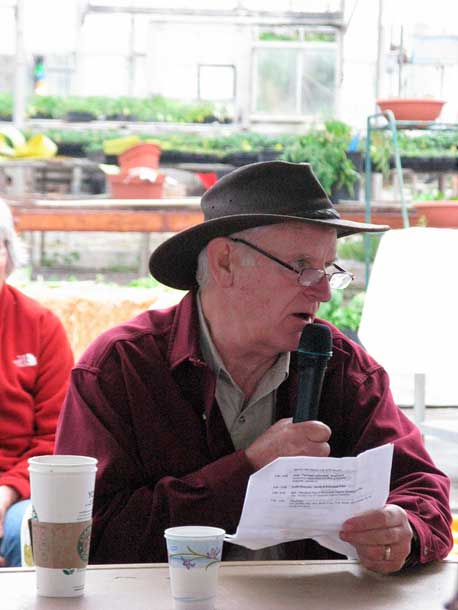Organic and sustainable aren’t terms often associated with Richmond, home to a Chevron refinery and a General Chemical plant. But those were two of the most frequently heard words on Saturday, at the first-ever West Contra Costa County Urban Agriculture Summit in North Richmond. Despite pouring rain, nearly 100 people gathered at Sunnyside Organic Seedlings to exchange ideas about bringing new models of food-growing to the area.
“Our goal here is to expand opportunities for urban agriculture in West Contra Costa County,” said County Supervisor John Gioia, who helped organize the event. He cited access to healthy food, environmental stewardship, and job opportunities as motivation.
Tom Butt, Richmond’s vice-mayor and the event’s co-organizer, agreed. “Ultimately, you want a healthier environment and you want healthier people,” he said. “If people are growing and eating food that’s fresh and local, there’s nothing better than that.”
To that end, the summit featured panelists who could share their experiences with urban agriculture models and challenges to local urban farming.
- Vice-Mayor Tom Butt assures Richmond citizens that there are no legal obstacles to urban farming in the city. Photo by Erica Reder.
Doria Robinson, executive director of the nonprofit Urban Tilth, addressed both topics. Her organization, active since 2004, operates 13 community farms in and around Richmond.
Robinson said the area’s assets and needs invite small-scale farming. “One thing that Richmond is really rich in is land,” she said. “We have really great weather. But there’s not a lot of places for people to meet and hang out. There’s all these vacant lots, and people who need work. So we’re solving three major issues as well as health issues.”
Urban Tilth serves more than a thousand people each year in this city of about 100,000 residents, but Robinson hopes to see that number grow. “I think that if we were able to serve five to six percent of the population of Richmond, that would be amazing,” she said. “Especially because the kind of interactions we have are so deep.”
Richmond officials are looking at ways to make that possible, thanks to a new Community Health and Wellness element added to the city’s general plan. “One action of that is to promote urban agriculture, to promote better access to food,” explained Jennifer Ly, a sustainability associate for the city.
Over the past few months, Ly and other staff members have been working on an urban agriculture assessment that will provide policymakers with data about existing programs and future possibilities.
Lina Velasco, from the city planning department, said the document could positively impact organizations like Urban Tilth. “It really looks at how can the city improve our policies to provide more security for the groups doing this work,” she said.
The staff plans to present its findings to city legislators in the fall.
But in the meantime, Supervisor Butt assured Richmond residents that they could keep up – or take up – urban farming practices. “You can keep bees in Richmond,” he said. “You can keep goats in Richmond. You can pretty much do whatever you want to, unless it bothers someone else.”
Butt said he wanted to make sure that anyone who wanted to farm could. “One of the things we want to do is make sure that the city and county’s planning policies and ordinances do not hinder the opportunity for people to practice urban agriculture,” he said.
Supervisor Gioia echoed that concern. “We are actually looking at how to develop a [commercial] category for urban agriculture that would be more flexible to allow these types of operations to be successful,” he said.
Robinson is optimistic about the government plans. “There’s some really great staff members, honestly looking for ways to improve health and wellness,” she said.
But a long road still lies ahead. “It takes a long time to make cultural change, which is what we’re trying to do,” said Robinson. “We’re trying to change the food culture.”

.jpg)




